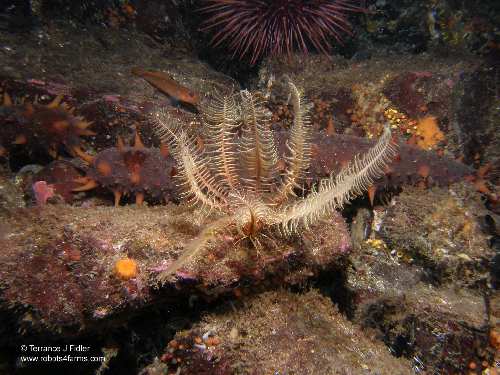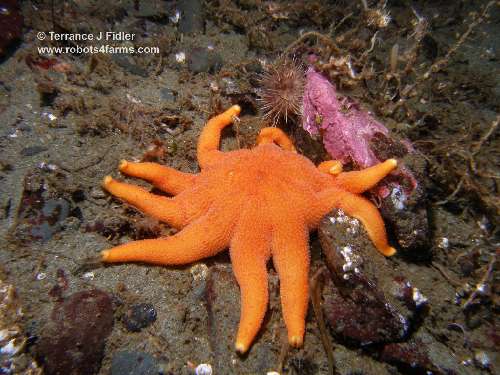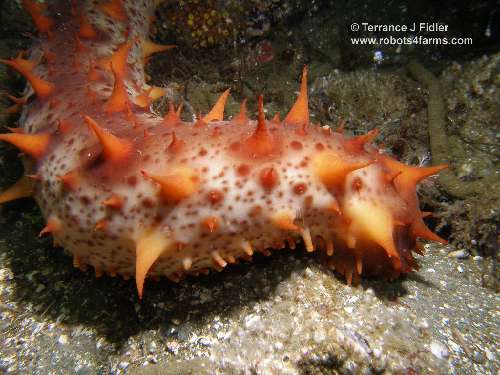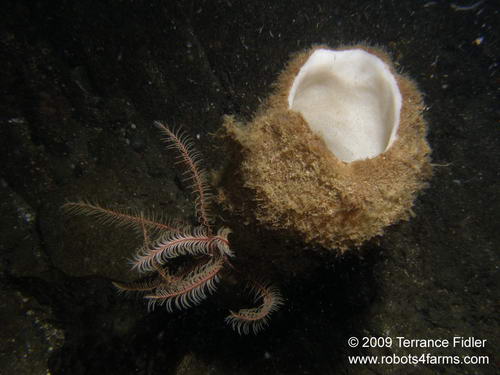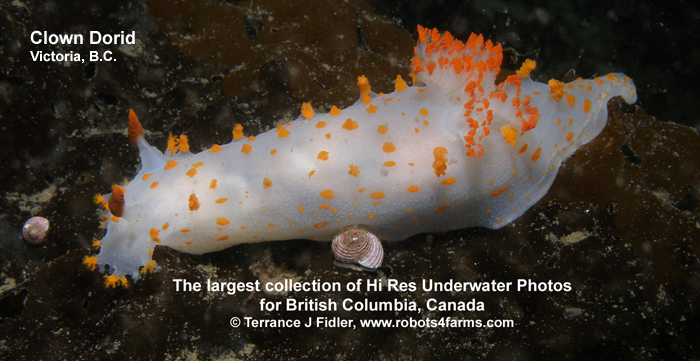
| Scuba Diving Pictures Main Page |
|
|
 Alberthead
Lagoon in Metchosin, B.C.
Alberthead
Lagoon in Metchosin, B.C. Bear Cove in Port Hardy, B.C. Bob's Spot in the Plumper Island Group, B.C. Braemar Ave in North Saanich, B.C. Breakwater Island near Gabriola Pass, B.C. Browning Passage near Port Hardy, B.C. Browning Wall near Port Hardy, B.C. China Creek near Port Alberni, B.C. Clover Point in Victoria, B.C. Copper Cliffs near Campbell River, B.C. Daphne Islet near Brentwood Bay Deep Cove near Sidney, B.C. Discovery Island near Victoria, B.C. Dolphin Beach near Nanoose Bay, B.C. Elliot's Beach Park in Ladysmith, B.C. Five Fathom near Port Hardy, B.C. Forest Island (north end) near Sidney, B.C. GB Church [ship to reef] near Sidney, B.C. Gowland Point on South Pender Island, B.C. Henderson Point near Sidney, B.C. Madrona Point in Nanaimo, B.C. Maple Bay near Duncan, B.C. McKenzie Bight near Victoria, B.C. McNeill Point aka Kitty Islet in Victoria, B.C. Neck Point in Nanaimo, B.C. Northeast Pearse Wall, Telegraph Cove, B.C. Ogden Point in Victoria, B.C. Porteau Cove Marine Park, B.C. Port McNeil, B.C. Rocky Point in Nanaimo, B.C. Row & Be Damned near Campbell River, B.C. Saltery Bay near Powell River,B.C. Saxe Point in Esquimalt, B.C. Sidney, B.C. Ten Mile Point in Victoria, B.C. Wall Beach near Nanoose Bay, B.C. Whytecliff Park near Vancouver, B.C. Willis Point near Sidney, B.C. International Kailua-Kona on the Big Island of Hawaii, USA Kaui - an Island of Hawaii, USA Aquatic but Non-Marine Life Vancouver Island, B.C. |
Scuba
Diving
Pictures from Neckpoint Park
in Nanaimo, B.C. Canada.
Which
includes Keel Cove as well as part of this park. These are mostly medium quality jpegs. But I have the RAW images as well. Email tjfidler@telus.net Directions to the dive site are located at the bottom of this page. Type of dive: shore dive but might want to do it as a boat dive as can be a long walk Rating for this dive site: 8/10 for its regular decent water quality, rock walls and abundance of life Parking: 8/10 lots of parking in first parking lot 30+ spaces, only about 7 spaces in second parking lot Boat ramp: none Ease of entry: long walk but trails are flat & wide for the most part. [Wheel chair access: No] Abundance of life: 8/10 Accommodations: There are several places in Nanaimo that you could find lodging at. Hotels and Inns. Attractions: Easy access to rock walls near shore, and not affected by current usually. But a bit of a walk from main parking lot. Bottom and depth: small rock material for shore, with sand at depth, lots of rock structure and walls Facilities: Portable toilets Hazards/Obstacles: Sometimes there are boats here. But fairly safe for the most part. Sensitivity to tide/current: current can be a problem, but tide is not usually an issue Terrain: solid rock & small rock larger than gravel on shores, rocky & sandy at depth, solid rock walls close to shore Tides, transportation and weather: Fisheries and Oceans Canada Tide Page., BC Ferries Schedule and Sailing's. , The Weather Network Other comments: I've now added some widescreen versions of some of the images. Look for a link below the image to get a widescreen version.
Just clicking on the ads helps pay for the web site. |
The following images are thumbnails. If you click on them a larger image will open up and the picture will take up most of your screen. Again these are medium quality jpegs. Higher quality images can be purchased directly from me via paypal using my email address tjfidler@telus.net And many of these photos can be found for sale on Cafepress through the Calendar link and Photo CD link . As well some of these can be found as posters via Cafepress, and some of these ocean life photographs are available as widescreen backgrounds via the widescreen link immediately below some of the photographs.
A few people have already asked me about "What is that pink stuff on the rocks in some of the pictures?" Well, they're usually Pink Rock Crust (aka Encrusting Coralline Algae) or in some cases might even be Encrusting Hydrocorals. They're eaten by a variety of animals - apparently as a good source of calcium.
Cephalopods
 |
 |
| A young Pacific Giant Octopus
[aka PGO] and a baby Moon Snail. The baby is on the top left of the image. PGO has a 6 inch [15 cm] mantle-head length.[Enteroctopus dolfeini] (March 22, 2008) |
Same Pacific Giant Octopus as on
the left. But now in its hunting mode, where it uses its arms like a net. Opening up its skin to form an umbrella shape. (March 22, 2008) Click on this link for a widescreen version of this photograph. |
 |
 |
| By popular demand here are some
more pictures of this juvenile PGO or Pacific Giant Octopus. Took over forty pictures of this octopus and a short video. If you look carefully you may see the large copepod in from of the octopus. [Enteroctopus dolfeini] |
This is one of my favorite
pictures of this octopus. (March 22, 2008) Click on this link for a widescreen version of this photograph. [Enteroctopus dolfeini] |
| |
 |
| A youtube video of the octopus
from above. Just it moving around. It initially was just sitting on the bottom as shown in the first still in this series, but after I just sat with it for a while it started to hunt, and feel under rocks for food - I'm guessing. |
Pacific Giant Octopus [aka PGO]
hiding between two rocks. Size ~ 6 inches [15 cm] tall. Note the large Brittle Star in front of it. [Enteroctopus dolfeini] (Apr 16, 2009) |
 |
|
| Squid of some kind. But its too
large to be any of the ones in my books that are found here. This piece was arount 12 inches [30 cm] long. But this is only the head and its tentacles. Body would be twice that. So, not sure what kind it is. (Apr 17, 2009) |
|
|
If you like these pages, and wish this
web site to continue, please remember to check out some of the Google
Ads. Just clicking on them helps pay for the web site.
Back to top.Crustaceans
 |
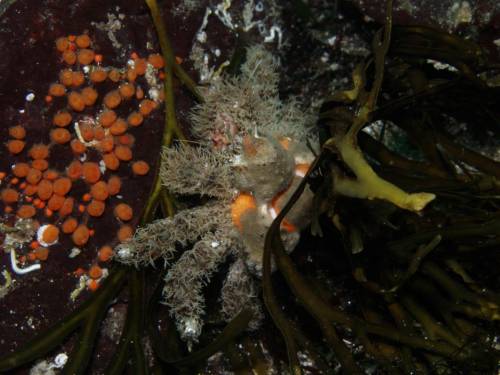 |
| Golf Ball Crab [aka Rhinoceros
Crab] ~ about 4 inches [10 cm] wide on the main body of its carapace. Common here. [Rhinolithodes wosnesseskii] ( January 24, 2006) |
Golf Ball Crab - same animal as
on left. ( January 24,
2006) This image also appears on the ocean-life calendar 2009 for Crustaceans of the Pacific Northwest. North America 2009 Calendar v01 |
 |
 |
| Sharp Nosed Crab ~ about 4
inches [10 cm] along main its shell for a length. Common here.[Scyra acutifrons] ( December 23, 2006) |
Sharp Nosed Crab ~ 5 inches
[12.5 cm] wide across the arms. [Scyra acutifrons] ( January 24, 2006) |
 |
 |
| Sharp Nosed Crab ~ 6
inches [15
cm] wide. [Scyra acutifrons] ( January 24, 2006) |
Bering Hermit Crab wearing a Leafy Hornmouth shell ( January 24, 2006) |
 |
|
| Butterfly Crab [Cryptolithodes
typicus] ~ 2.5 inches
[6.25 cm] wide. Note the rounded "nose" this is what makes it different from the Umbrella Crab which has a square "nose." (May 21, 2006) |
Red Rock Crab ~ 2.5 inches [6.25
cm] wide. It has juvenile colours. (December 23, 2006) |
 |
 |
| Puget Sound King Crab
[Lopholithodes mandtii] ~ 12
inches [30 cm] wide. (September 24, 2006) Not that common here. I'm pretty sure I've seen the same one more than once. |
Puget Sound King Crab
[Lopholithodes mandtii] ~ 12
inches [30 cm] wide. (September
24, 2006) This photo also appears on the marine-life calendar 2009 for Underwater Life of the Pacific Northwest. North America 2009 Calendar v02 |
 |
 |
| Slender Decorated Crab [covered in "hair"] & Clown Dorid (December 23, 2006) | Juvenile Golfball Crab ~ 2 inches [5 cm] across shell (Sept 23, 2007) |
 |
 |
| Heart Crab ~ 6 inches [15 cm]
wide with the legs. [Phyllolithodes papillosus] (June 2, 2007) |
Kelp Crab ~ about 3 inches [7.5
cm] wide on main body. True to its name I usually find them on the
kelp, seaweeds & seagrasses. Common here. (June 2, 2007) |
 |
 |
| Heart Crab ~ abut 4 inches [10
cm] wide on main shell. Common here. [Phyllolithodes papillosus](Sept 23, 2007) |
Two Heart Crabs. Can you see the
baby? [Phyllolithodes papillosus] (Sept 23, 2007) |
 |
 |
| Kelp Crab ~ 8 inches [20 cm] wide with legs. Very common here. (Sept 23, 2007) | Northern Kelp Crab ~ 14 inches [35 cm] wide with the legs. (Sept 23, 2007) |
 |
 |
| Redrock Crab ~ 10 inches [25 cm]
wide. Quite common here. [Cancer productus] (June 2, 2007) |
Widehand Hermit Crab ~ 2 inches
[5 cm] across the shell. Not common at this dive site. (June 2, 2007) |
 |
 |
| Small Barnacles and Orange Ascidians [Sea Squirts] (June 2, 2007) | Golf Ball Crab [aka Rhinoceros
Crab] ~ 4 inches [10 cm] across its main shell or carapace [exoskeleton]. Common at this location. [Rhinolithodes wosnesseskii] (March 22, 2008) |
 |
 |
| Decorator Crab wearing bits of
brown kelp. Width across legs about 5 inches [12.5 cm]. (March 22, 2008) |
Scaled Crab [Placetron
wosnessenskii] ~ 14 inches [35 cm]
across. This is the first adult I have ever seen. But I have images of two very young ones from Deep Cove near Brentwood Bay, and one from Spring Bay [near Ten Mile Point] in Victoria. (Apr 17, 2009) |
|
|
If you like these pages, and wish this
web site to continue, please remember to check out some of the Google
Ads. Just clicking on them helps pay for the web site.
Back to top.Fish
 |
 |
| Not sure of name - possibly a Cabezon ?( January 24, 2006) | Sculpin but not sure of exact
name. This fish was about 6 inches [15 cm] long. ( January 24, 2006) |
 |
 |
| Sculpin - same individual from
previous image ( January 24, 2006) This sculpin actually kept coming closer to me. One of the reasons I'm so fond of sculpins. They seem to be very curious and brave fish. In hindsight, I should have taken even more pictures of this individual. |
Sculpin - female of one above & to right - or so I'm told me ( January 24, 2006) |
 |
|
| Ronquil of some kind (?) ~ 5 inches [12.5 cm] long. ( January 24, 2006) | Pacific Sanddab - odd name. ~ 12
inches [30 cm] long. (May
21,
2006) |
 |
|
| Starry Flounder [?] ~ 12 inches
[30 cm] long. [Platichthys stellatus] (May 21, 2006) |
2 Sculpins of some kind ~ 4
inches [10 cm] long. These fish were almost on shore as were several of the sculpins. Very common here. (May 21, 2006) |
 |
|
| Sculpin of some kind ~ about 4 inches [10 cm] long. (May 21, 2006) | Quillback Rockfish ~ 14 inches
[35 cm] long.[Sebastes maliger] (May 21, 2006) This image also appears on the ocean-life calendar 2009 for Underwater Life of the Pacific Northwest. North America 2009 Calendar v02 |
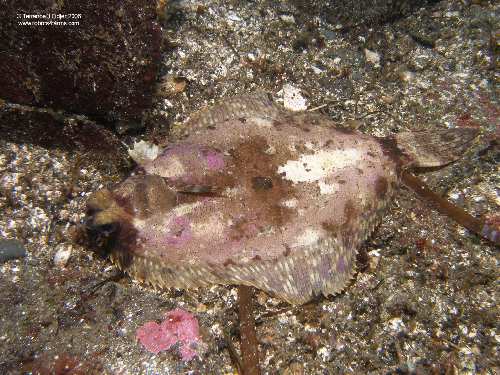 |
 |
| C-O Sole ~ 12 inches [30 cm]
long. [Pleuronichthys coenosus] (September 24, 2006) |
Decorated Warbonnet ~ 5 inches
[12.5] cm tall for the head. (September
24, 2006) This photo can be found on the ocean-life calendar 2009 for Fishes v01 & Underwater Life v02 of the Pacific Northwest. North America 2009 Calendar v01 This image was also used to advertise the opening of the Shaw Ocean Discovery Centre in the Times Colonist Newspaper in Victoria. |
 |
 |
| Irish Lord [Hemilepidotus
hemilepidotus] ~ 16 inches [40 cm]
long. This was the first one I saw at this dive site. (September 24, 2006) This photo also appears on the marine-life calendar 2009 for Underwater Life of the Pacific Northwest. North America 2009 Calendar v02 |
Kelp Greenling [Hexagrammos
decagrammus] - female ~ 20
inches [50 cm] long. (September 24, 2006) |
 |
 |
| Northern Spearnose Poacher ~ 8
inches [20 cm] long. I've only seen these fish here at night. (September 24, 2006) |
Sailfin Sculpin [Nautichthys
oculofasciatus] ~ 8 inches [20
cm] long. (September 24, 2006) This image can be found on the ocean-life calendar 2009 for Fishes of the Pacific Northwest. North America 2009 Calendar v01 |
 |
 |
| Yelloweye Rockfish ~ 6 inches
[15 cm] long. (September
24, 2006) |
Grunt Sculpin on a bed of
Disc-Top Tunicates. The fish is approximately 3 inches [7.5 cm] long. Quite common here. And since these fish don't swim it is easy to get close to them. If you can spot them. [Rhamphocottus richardsonii] (December 23, 2006) |
 |
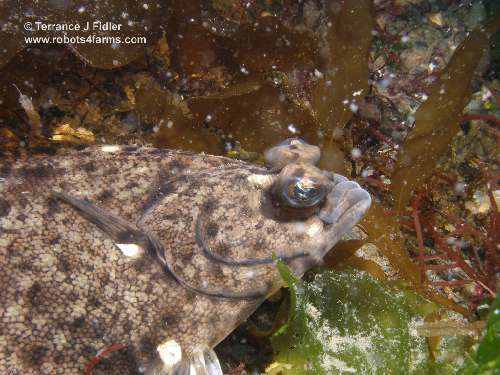 |
| Painted Greenling ~ 12 inches
[30 cm] long. This is a larger specimen of this fish than what I normally spot. [Oxylebius pictus] (December 23, 2006) |
English Sole [?] ~ 14 inches [35
cm] long for entire body. [Parophys vetulus] (June 2, 2007) |
 |
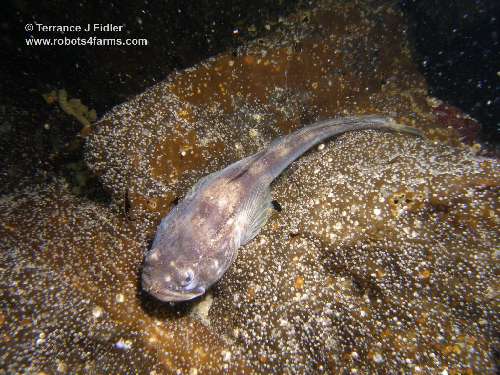 |
| Longfin Sculpin ~ about an inch
and a half [3.75 cm] long - juvenile [Jordania zonope] (June 2, 2007) |
Plainfin Midshipman ~ 10 inches
[25 cm] long. Not very common here. But it may be that I just have not spotted them as often as I should have. (June 2, 2007) |
 |
 |
| Longfin Sculpin ~ 5 inches [12.5
cm] long. Not a very good picture. But better than none. Will replace this in the future. Common here. [Jordania zonope] (March 22, 2008) |
Cabezon ~ 14 inches [35 cm]
long. [Scorpaenichthys marmoratus] Rare for me to see them here. (March 22, 2008) |
 |
 |
| Scalyhead Sculpin ~ 5 inches
[12.5 cm] long. Common here. (March 22, 2008) |
Sculpin of some kind. ~ 6 inches [15 cm] long. (March 22, 2008) |
 |
 |
| I think this is an Eelpout ~ 12
inches [30 cm] long. Rare - first I've ever seen. (March 22, 2008) |
Ling Cod ~ 20 inches [50 cm]
long. Just a young one based on its size. I have seen them over 6 feet [2 m] long. But not at this dive site. I have in fact rarely seen any here. [Ophiodon elongates] (Apr 16, 2009) |
 |
 |
| Red Irish Lord [Hemilepidotus
hemilepidotus] ~ 12 inches [30
cm] long. Not that common here. A juvenile fish based on its size. (Apr 17, 2009) |
Red Irish Lord [Hemilepidotus
hemilepidotus]. Same fish as
that on the left of this image. But I thought a close up would be nice given how beautiful the colours are. (Apr 17, 2009) |
 |
|
| Longspine Sculpin ~ 12 inches
[30 cm] long. [aka Longspine Combfish] This is the first time I have ever seen one of these fish. So, not common where I've been diving. [Zaniolepis latipinnus] (Apr 17, 2009) |
|
|
If you like these pages, and wish this
web site to continue, please remember to check out some of the Google
Ads. Just clicking on them helps pay for the web site.
Back to top.Mollusks
|
|
If you like these pages, and wish this
web site to continue, please remember to check out some of the Google
Ads. Just clicking on them helps pay for the web site.
Back to top.Nudibranchs [or Sea Slugs] & Snails
 |
|
| Young White Lined Dirona ~ 1.5 inches [3.75 cm] long. ( January 24, 2006) | Giant Dendronotid ~ 10 inches
[25 cm] long. [Dendronotus iris] (May 21, 2006) This photo also appears on the marine-life calendar 2009 for Underwater Life of the Pacific Northwest. North America 2009 Calendar v03 |
| Giant Dendronotid ~ about 16
inches [40 cm] long. [Dendronotus iris] Very common here as there are also lots of tube dwelling anemones here. (May 21, 2006) |
Giant Dendronotid ~ 12 inches
[30 cm] long. [Dendronotus iris] (May 21, 2006) This photo also appears on the marine-life calendar 2009 for Mollusks of the Pacific Northwest. North America 2009 Calendar v01 |
 |
 |
| White Lined Dirona ~ 6 inches
[15 cm] long. Common here. (May
21, 2006) |
Red Flabellina - a nudibranch ~
2 inches [5 cm] long.
(September 24, 2006) |
 |
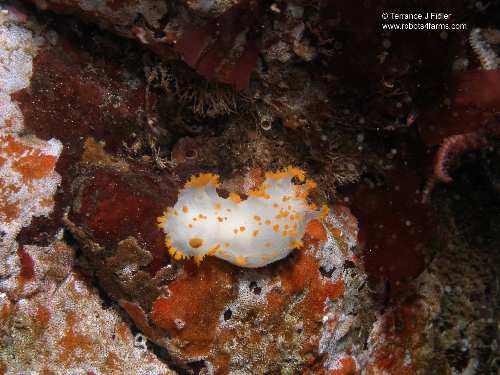 |
| Moon Snail ~ 12 inches [30 cm]
long. (September 24, 2006) This image also appears on the ocean-life calendar 2009 for Mollusks Life of the Pacific Northwest. North America 2009 Calendar v01 |
Clown Dorid [Triopha catalinea]
~ about 4 inches [10
cm] long. First I've seen here. (December 23, 2006) |
 |
 |
| Gold Dirona ~ about 3 inches
[7.5 cm] Common on the keel cove side or entry. (Sept 23, 2007) |
Gold Dirona ~ 3 inches [7.5 cm]
long. The sea cucumber did not seem to react at all to the nudibranch crawling all over it. (June 2, 2007) |
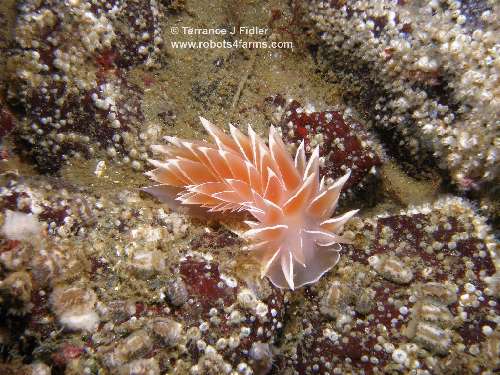 |
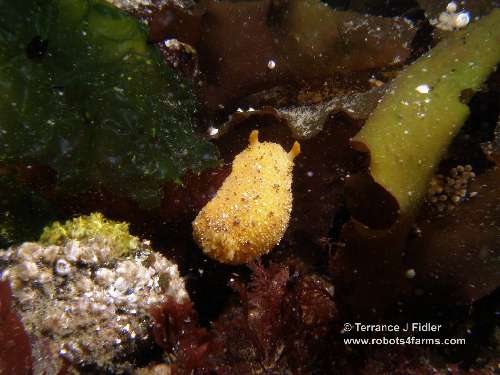 |
| Gold Dirona ~ 5 inches [12.5 cm]
long. And several Barnacle
Eating Dorids. There was hundreds of the Barnacle Eating Dorids visible this day. (June 2, 2007) |
Sea Lemon [Doris montereyensis] ~ 3 inches [7.5 cm] long. (June 2, 2007) |
 |
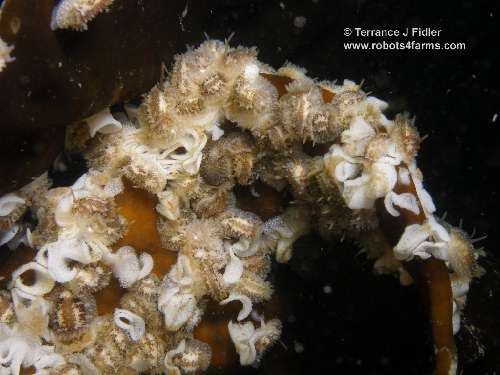 |
| Group of Barnacle Eating Dorids.
Each only about an inch [2.5 cm] long. (June 2, 2007) |
Group of Barnacle Eating Dorids. Possibly laying eggs. (June 2, 2007) |
 |
 |
| California Armina [aka Striped
Nudibranch] ~ 6 inches [15 cm] long. I had never seen these animals here before, but this day during the dive I encountered about ten of them. (Apr 17, 2009) |
Striped Nudibranch [aka
California Armina] ~ 6 inches [15 cm] long each. (Apr 16, 2009) |
 |
|
| White and Orange Tipped
Nudibranch ~ 2.5 inches [6.25 cm] wide. This one seems to be much larger than what the book I have describes. Not the first I've seen here, but the only one that the picture turned out. (Apr 17, 2009) [Janolus fuscus] |
|
|
Back to top.
Sea Anemones & others ( Cnidarians )
 |
 |
| Painted Anemone ~ 14 inches [35
cm] wide. [Urticina crassicornis] ( Aprile 16, 2009) |
Orange Cup Corals ~ 1 inch [2.5
cm] wide. [Balanophyllia elegans] ( January 24, 2006) |
| Orange Cup Corals ~ 1 inch [2.5
cm] wide. [Balanophyllia elegans] ( May 21, 2006) |
Orange Cup Corals ~ 1 inch [2.5
cm] wide. [Balanophyllia elegans] ( May 21, 2006) |
| Sea Blubber or Lions Mane ~ 14
inches [35 cm] across main body or "bell. " This image was also used to advertise the Shaw Ocean Discovery Centre and appears in some of this centres pamphlets. [Cyanea capillata] ( May 21, 2006) |
Snakelock Anemone ~ 12 inches
[30 cm] wide. (May 21, 2006) |
 |
|
| Tube Dwelling Anemones - a
favourite food of Dendronotids Very common here and they attract the Giant Dendronotids. [Pachycerianthus fimbriatus] (May 21, 2006) |
Swimming Anemone ~ 8 inches [20
cm] across. Not that common here. [Stomphia didemon] (December 23, 2006) |
 |
 |
| Buried Anemone - aka Stubby Rose
Anemone - not so buried
though. ~ 8 inches [20 cm] wide. Yes, this one has a crab in its mouth. Not sure if it killed it or just happen to get a hold of the body of this crab. (December 23, 2006) |
Swimming Anemone ~ 12 inches [30
cm] tall in this image. There are now several young ones in the area. So, perhaps the adults will become common. [Stomphia didemon] (Apr 17, 2009) |
 |
 |
| 3 species of anemones. Larges
about 2 inches [5 cm] tall. Orange Cup Coral, a White Anemone, and some others that I'm not able to identify from my books. |
White Anemone ~ 3 inches [7.5
cm] wide. Spotted several of these this day. So, quite common here. (Apr 16, 2009) |
 |
 |
| White Anemone ~ 3 inches [7.5
cm] wide. I liked this image, but also wante to include the other one as well. I will try and restrain my self to not duplicate too many images of the same species on the same dive site page. (Apr 16, 2009) |
Lobed Sea Gooseberry ~ 3 inches
[7.5 cm] long. Common here. |
|
|
If you like these pages, and wish this web site to continue, please
remember to check out some of the Google Ads. Just clicking on the ads
helps pay for the web site.
Back to top.Starfish & Sea Urchins & Sea Cucumbers (Echinoderms)
|
|
If you like these pages, and wish this web site to continue, please
remember to check out some of the Google Ads. Just clicking on the ads
helps pay for the web site.
Back to top.Sponges
Back to top.
Tunicates
Back to top.
Worms
Back to top.
Miscellaneous
|
|
Back to top.
Neck Point
If coming from the Ferry Terminal make a left onto Brechin Road just as you leave the Departure Bay Ferry Terminal area. Follow it up to the lights, staying on the right side of the road. When you get to the lights you will be making a right onto Estevan Road - which almost immediately becomes Departure Bay road. Follow Departure Bay Road and after you pass the beach at the bottom of the hill, make a left onto Hammond Bay Road. Follow this for a few kilometers then make a right onto Morningside Drive and drive past the school, and you will see the sign for Neck Point. You will need to park in the lower parking lot. The main one shown on the web page.
If you want to print out a map you can user either:
Google Maps : enter Morningside Drive Nanaimo BC Note that it will return Keel Cove Lane.
or
MapQuest : enter Morningside Drive for the Address, Nanaimo for the City, BC for the State/Province
Keel Cove
An alternate dive just a street over from the physical Neck Point is Keel Cove. Part of the same Park really. Follow Hammond Bay Road basically one street past Morningside Road and then turn right onto McGuffie Road then make a right onto Keel Cove Lane. Just a couple of parking spots in the trees near someone's house at the edge of the park. The path down is pretty good. You will see the beach from the parking spots.
If you want to print out a map you can user either:
Google Maps : enter Keel Cove Nanaimo BC Note that it will return Keel Cove Lane.
or
MapQuest: enter Keel Cove for the Address, Nanaimo for the City, BC for the State/Province
Copyright © 2006 - 2010 by
Terrance J.
Fidler.
All rights reserved.











